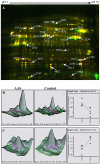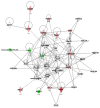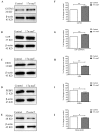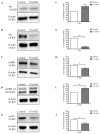Differential protein expression profile in the hypothalamic GT1-7 cell line after exposure to anabolic androgenic steroids
- PMID: 28719635
- PMCID: PMC5515402
- DOI: 10.1371/journal.pone.0180409
Differential protein expression profile in the hypothalamic GT1-7 cell line after exposure to anabolic androgenic steroids
Abstract
The abuse of anabolic androgenic steroids (AAS) has been considered a major public health problem during decades. Supraphysiological doses of AAS may lead to a variety of neuroendocrine problems. Precisely, the hypothalamic-pituitary-gonadal (HPG) axis is one of the body systems that is mainly influenced by steroidal hormones. Fluctuations of the hormonal milieu result in alterations of reproductive function, which are made through changes in hypothalamic neurons expressing gonadotropin-releasing hormone (GnRH). In fact, previous studies have shown that AAS modulate the activity of these neurons through steroid-sensitive afferents. To increase knowledge about the cellular mechanisms induced by AAS in GnRH neurons, we performed proteomic analyses of the murine hypothalamic GT1-7 cell line after exposure to 17α-methyltestosterone (17α-meT; 1 μM). These cells represent a good model for studying regulatory processes because they exhibit the typical characteristics of GnRH neurons, and respond to compounds that modulate GnRH in vivo. Two-dimensional difference in gel electrophoresis (2D-DIGE) and mass spectrometry analyses identified a total of 17 different proteins that were significantly affected by supraphysiological levels of AAS. Furthermore, pathway analyses showed that modulated proteins were mainly associated to glucose metabolism, drug detoxification, stress response and cell cycle. Validation of many of these proteins, such as GSTM1, ERH, GAPDH, PEBP1 and PDIA6, were confirmed by western blotting. We further demonstrated that AAS exposure decreased expression of estrogen receptors and GnRH, while two important signaling pathway proteins p-ERK, and p-p38, were modulated. Our results suggest that steroids have the capacity to directly affect the neuroendocrine system by modulating key cellular processes for the control of reproductive function.
Conflict of interest statement
Figures





Similar articles
-
Mechanisms of anabolic androgenic steroid inhibition of mammalian epsilon-subunit-containing GABAA receptors.J Physiol. 2006 Jun 15;573(Pt 3):571-93. doi: 10.1113/jphysiol.2006.106534. Epub 2006 Mar 16. J Physiol. 2006. PMID: 16543268 Free PMC article.
-
Chronic exposure to anabolic androgenic steroids alters activity and synaptic function in neuroendocrine control regions of the female mouse.Neuropharmacology. 2011 Sep;61(4):653-64. doi: 10.1016/j.neuropharm.2011.05.008. Epub 2011 May 27. Neuropharmacology. 2011. PMID: 21645530 Free PMC article.
-
Anabolic steroids induce region- and subunit-specific rapid modulation of GABA(A) receptor-mediated currents in the rat forebrain.J Neurophysiol. 2000 Jun;83(6):3299-309. doi: 10.1152/jn.2000.83.6.3299. J Neurophysiol. 2000. Retraction in: J Neurophysiol. 2007 Sep;98(3):1841. doi: 10.1152/jn.z9k-8459-Retraction.2007. PMID: 10848550 Retracted.
-
Anabolic androgenic steroid abuse: multiple mechanisms of regulation of GABAergic synapses in neuroendocrine control regions of the rodent forebrain.J Neuroendocrinol. 2012 Jan;24(1):202-14. doi: 10.1111/j.1365-2826.2011.02151.x. J Neuroendocrinol. 2012. PMID: 21554430 Free PMC article. Review.
-
How is GnRH regulated in GnRH-producing neurons? Studies using GT1-7 cells as a GnRH-producing cell model.Gen Comp Endocrinol. 2017 Jun 1;247:138-142. doi: 10.1016/j.ygcen.2017.01.025. Epub 2017 Jan 25. Gen Comp Endocrinol. 2017. PMID: 28131616 Review.
References
-
- Wood RI. Reinforcing aspects of androgens. Physiol Behav. 2004;83: 279–289. doi: 10.1016/j.physbeh.2004.08.012 - DOI - PubMed
-
- Dodge T, Hoagland MF. The use of anabolic androgenic steroids and polypharmacy: A review of the literature. Drug and alcohol dependence. 2011. doi: 10.1016/j.drugalcdep.2010.11.011 - DOI - PMC - PubMed
-
- van Amsterdam J, Opperhuizen A, Hartgens F. Regulatory Toxicology and Pharmacology. Regulatory Toxicology and Pharmacology. Elsevier Inc; 2010;57: 117–123. - PubMed
-
- Penatti CAA, Davis MC, Porter DM, Henderson LP. Altered GABAA Receptor-Mediated Synaptic Transmission Disrupts the Firing of Gonadotropin-Releasing Hormone Neurons in Male Mice under Conditions That Mimic Steroid Abuse. Journal of Neuroscience. 2010;30: 6497–6506. doi: 10.1523/JNEUROSCI.5383-09.2010 - DOI - PMC - PubMed
-
- Penatti CAA, Oberlander JG, Davis MC, Porter DM, Henderson LP. Chronic exposure to anabolic androgenic steroids alters activity and synaptic function in neuroendocrine control regions of the female mouse. Neuropharmacology. 2011;61: 653–664. doi: 10.1016/j.neuropharm.2011.05.008 - DOI - PMC - PubMed
MeSH terms
Substances
Grants and funding
LinkOut - more resources
Full Text Sources
Other Literature Sources
Medical
Research Materials
Miscellaneous

